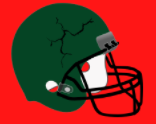CTE: Football’s Silent Killer

Curtsey of Ben Chapman
On January 2nd 2022, Tampa Bay Buccaneers wide receiver Antonio Brown removed his pads and gear, throwing them into the stands. He then held up a peace sign for the audience and ran off the field. This incident is only the latest in a long line of infamously erratic behavior from the receiver, who has found himself bouncing from franchise to franchise as a result of his conduct. Brown, however, did not always behave this way and fans have long pondered as to what exactly sent him down this path.
One particular incident comes to mind. On January 9, 2016, Brown took a helmet-to-helmet hit in a game against the Bengals which left him knocked out on the field for minutes. Although it has never been medically confirmed, fans widely suspect that this hit may be in some way responsible for the changes in his behavior, as it was only after this hit that Brown began to frequently involve himself in increasingly asinine antics off the field. This has ranged from disputes about what type of helmet he was allowed to use to allegations of sexual assault.
Brown would not be the first former Steeler to have their behavior altered by head trauma. The late Mike Webster, a Hall of Fame Center, suffered from incredibly erratic behavioral patterns following his retirement from the NFL. Webster would later end up being the first NFL player to ever be diagnosed with Chronic Traumatic Encephalopathy (CTE), which is a condition that slowly works to atrophy the brain over an extended period of time. There have been many other cases like that of Brown and Webster’s, not only in the NFL, but other contact sports as well.
Since CTE can only be diagnosed posthumously, it’s impossible to say with one hundred percent certainty whether or not Brown, or any other living player is suffering from CTE, but the hard data still raises plenty of alarm. A 2017 study from Boston University reported that ninety-nine percent of brains obtained from former NFL players showed signs of CTE, whereas only twenty-one percent of those obtained from high school football players showed signs of the disease. This has left parents across the United States understandably concerned and participation in youth tackle football across the country has seen a universal and significant decline.
Despite this, the American Academy of Pediatrics refused to support a ban on tackle football for children under twelve, instead stressing the importance of proper technique and properly fitted equipment in keeping players safe. These issues with tackle football and head injuries will not be resolved easily, but should be ever present in the thoughts of those who will shape the future of the sport.
Hello there! Our goal is to provide relavent, engaging journalism for readers of all ages. Your donation will support the student journalists of the Wolfpacket at Claremont High School, and will allow us to purchase equipment, print our monthly issues, and enter in journalism competitions. We appreciate your consideration!

Ben Chapman is a Senior at Claremont High School and Sports Editor with the Wolfpacket. Chapman is a member of the CHS Speech and Debate team and avid...








